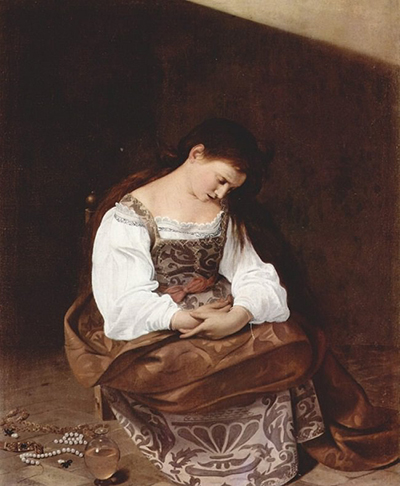Mary Magdalen is a controversial figure even today, and this has not changed since Caravaggio's time.
His Penitent Mary Magdalene (also known as Repentant Magdalene) is a powerful statement – but what, precisely, that statement is, is unknown.
Some critics felt that Caravaggio was making a statement about the treatment of prostitutes in his own time, using the Bible's best known fallen woman to raise awareness of the violence that these women faced. Magdalene, they say, is depicted slumped and defeated, her hands and face swollen, the violence implicit in the strand of broken pearls on the floor beside her.
Regardless of Caravaggio's intentions, his contemporaries were horrified by his depiction of Mary Magdalene as a modern (for their day) woman. She is attired in clothing that could have been seen on women in the streets and houses of Caravaggio's home town, and this clear linking of the Bible's alleged prostitute with modern women sat uncomfortably with many religious authorities.
But this disapproval was not universal – many clerics praised the painting, embracing the realism of the portrait and the clear lines of remorse and regret to be seen in the position of the woman's body.
Magdalene sits or kneels on a low stool, her hands clasped loosely in front of her, her head bent. A single tear traces its way down one pale cheek, and she is dressed in a white undershirt, with a brown or maroon patterned tunic over this. Magdalene's arms are softly curved into her lap, and her head, with her long brown hair flowing down her back, slightly unkempt, is tipped forward, almost as though she is asleep, or has abandoned herself to her regrets.
Comparing this painting to a later one, in which Caravaggio is believed to have used the same model, this time as the Madonna with a baby, there is, perhaps, a sense that Magdalene is mourning her lack of a child, her slumped head and curved arms displaying an emptiness in her life that a baby (and all that accompanies a child: husband, respectability, stability and so on) would have filled for her.
The shadows surrounding Magdalene add to this emptiness – it is impossible to say what will happen next for this woman, once a sinner but now heading, it seems, towards redemption...




